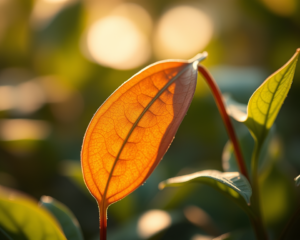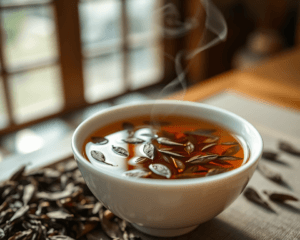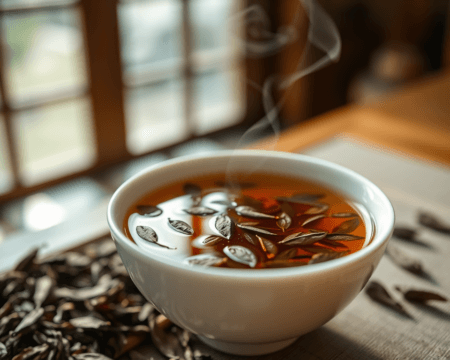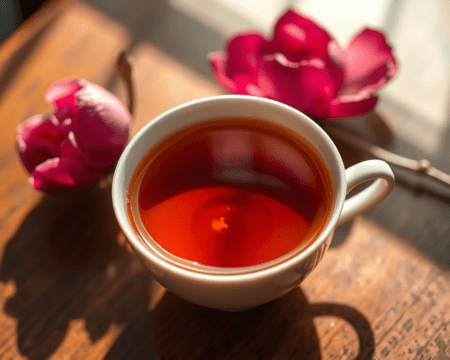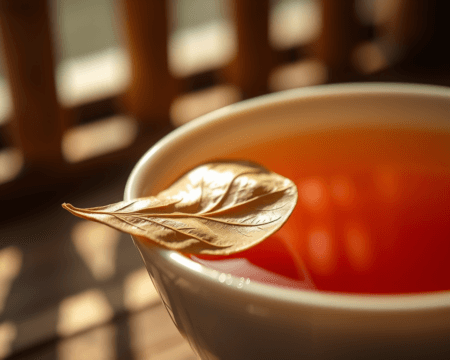Ever wondered why your favorite cup of tea sometimes makes your stomach a bit uneasy? Or why one tea hits you with that refreshing zing while another feels more muted? You’re not alone, and it all boils down to something super important: acidity. Today, I’m breaking down the nitty-gritty of acidity in tea, how it impacts your health, and even how it stacks up against other popular drinks like coffee and soda. Trust me; you’re gonna want to stick with me here.
Key Takeaways
- Tea has a variety of natural acids that influence its flavor and health effects.
- Different types of tea contain varying acidity levels, which can impact digestion and nutrient absorption.
- Understanding tea acidity can enhance your enjoyment and health benefits from this beloved beverage.
Understanding Acidity in Tea
What Does Acidity Mean in the Context of Tea?
When we talk about acidity in tea, we’re looking at its flavor profile, specifically the pH level that helps define how tangy or crisp your brew tastes. Most teas hover around a pH of 4-6, which, while technically acidic, is way less intense than your typical soda or lemon juice, which can drag you down to a pH around 2 or 3.
You might be wondering about the types of acids we’re dealing with here. Natural acids like citric, malic, and ascorbic acid contribute to the overall experience of tea. They can subtly shift how we perceive flavors. For instance, think about how a splash of lemon can liven up a dull dish with its tang—this is tea’s magic in a cup.
And those tannins? They add astringency, creating that mouth-drying feeling you sometimes get with black tea. So, when you sip your brew, remember: you’re tasting a complex interplay of organic acids and tannins that shape the experience.
Types of Acidity Found in Different Teas
Now, let’s break it down by some major players in the tea world. The type of tea you choose dramatically influences its acidity levels:
- Green Tea: With a lighter profile, it usually contains citric and ascorbic acids, giving it that refreshing quality. Brands like Sencha and Matcha shine here, with their vibrant flavors and rich health benefits.
- Black Tea: Higher in tannins, it can feel more robust and sometimes sharper on the tongue. If you’re sipping on Darjeeling or Earl Grey, you’re likely tasting those tannins—no wonder it can kick up your stomach acid if you’re sensitive!
- Herbal Tea: Often caffeine-free, these can vary widely. A herbal brew with hibiscus is known for higher acidity, while chamomile offers a gentler approach.
- Oolong Tea: Pretty much the middle-ground hero, oolong falls between green and black, with varying acidity levels depending on the processing style.
- White Tea: Mild and delicate, it usually presents a more neutral pH, often bringing you smooth sips without the sharp acidic bite.
All these teas offer unique experiences based on their acidity and natural compounds.
Health Implications of Tea Acidity
How Does Tea’s Acidic Content Affect Your Health?
Let’s get real: acidity isn’t just a flavor kicker; it has tangible health effects. You might be the life of the party sipping on that dark chai, but if you’ve got digestive issues, pay attention here.
Acid reflux is a big player for many tea drinkers. Those tannins and acids can provoke your stomach into overdrive, especially when sipping on an empty stomach or going heavy on black teas. If that describes you, switch to milder brews like herbal or white tea.
But it’s not all doom and gloom. The antioxidants and bioactive compounds found in tea can balance out some negative effects. Oolong and green teas, for instance, are rich in benefits that can help mitigate inflammation and even promote better nutrient absorption due to their unique acid blends. So, yes, that cuppa can pack a punch—just be mindful of how your body reacts!
Potential Health Benefits Linked to Tea Acidity
What’s great is that some acids in tea play a starring role in health benefits. The antioxidants in green tea can combat free radicals—think of them as little ninjas fighting for your health. Plus, ascorbic acid, found in citrus-infused blends, plays a role in boosting your immune system.
Here’s the kicker: teas with a higher acid content might also have anti-inflammatory properties. Many folks report better hydration and metabolic boosts when they enjoy tea regularly, which is great news if you’re looking to up your health game.
Comparing Tea Acidity to Other Beverages
How Does Tea’s Acid Content Compare to Coffee and Soft Drinks?
Believe it or not, tea is the less acidic friend in the beverage crowd. You pop open a soda, and you’re slapping down a pH level risky enough to take paint off a car. Coffee can vary but typically hovers around a pH of 5, which means it’s not as harsh as soda but still gives tea a run for its money.
Using specific brands can help personalize your comparison. For example, Pepsi and Coca-Cola can hit pH levels around 2.5. Yikes! When you consider a good brew, like Harney & Sons English Breakfast, you’re sipping something way gentler on your stomach.
But how does that impact your daily choices? If you’re prone to gastrointestinal issues, reaching for that herbal tea or a mild green tea instead of a dark roast coffee or soft drink could save you some serious discomfort. Plus, it’s a way to hydrate that actually gives back instead of weighing you down.
The Role of Acidity in Flavor: Tea vs. Other Beverages
You probably know that one Teavana blend with the fruity zing that makes your taste buds sing. That’s the flavor profile influenced directly by its acidity. In contrast, coffee tends to have more of a bitter element due to its higher tannin levels.
It’s interesting to note how acidity plays a role in what we crave. Many people lean toward refreshing beverages with a kick when they’re thirsty. This can mean the difference between choosing an iced tea over a heavier drink. Flavor preferences also shift dramatically; while some appreciate the crispness that acidity brings, others might steer clear if they find it too sharp.
Insights on Different Types of Tea and Their Acidity Levels
A Detailed Look at the Acidity of Common Tea Varieties
Here’s where it gets insightful: understanding the nuances of each tea’s acidity can enhance your drinking experience.
| Type of Tea | Acidity Level (pH) | Notable Acids | Flavor Profile |
|---|---|---|---|
| Green Tea | 6 – 6.5 | Citric, ascorbic | Fresh, grassy, vibrant |
| Black Tea | 4.9 – 5.5 | Tannins, catechins | Robust, astringent |
| Herbal Tea | 5.0 – 6.5 | Various (depends on blend) | Variable, often smooth |
| Oolong Tea | 5.0 – 6.0 | Malic, citric | Complex, floral, fruity |
| White Tea | 6.0 – 6.8 | Lower tannins | Light, sweet, floral |
Understanding this table can really enhance your tea-drinking game. The acidity levels vary, influencing how each tea interacts with your taste buds and stomach, plus offering insights into what might suit your preferences best.
User Experiences with Tea Acidity
Nothing beats hearing from real people about their tea adventures. I’ve seen folks on tea forums rave about how switching from black tea to a floral oolong changed their mornings for the better. Some shared their struggles with stomach discomfort from strong black brews, leading them to kinder, gentler options like rooibos or herbal infusions.
If you’re health-conscious and curious, exploring user experiences can ignite new ideas—maybe even inspire you to try out a new blend! The community around tea is vibrant and filled with shared insights, anecdotes, and daily rituals that can elevate your own routine.
So, whether you’re on the lookout for health benefits, flavor exploration, or just trying to navigate your way through the diverse world of tea, understanding acidity is a key player in the game. Remember, your choice of tea can influence not just your taste buds but your overall health. Cheers to making informed decisions and finding your perfect cup!
Frequently Asked Questions
What types of tea are generally the most acidic?
Black and green teas tend to have higher acidity levels compared to white and herbal teas. However, specific acidity can vary significantly based on the tea’s origin, processing methods, and preparation techniques.
How does the acidity of tea affect digestive health?
The acidity in tea can stimulate stomach acid production, which may enhance digestion for some individuals. However, excessive acidity might cause discomfort for those with sensitive digestive systems or acid reflux issues.
Is there a way to reduce the acidity in tea when brewing?
Yes, you can reduce the acidity of tea by using cooler water temperatures during brewing, steeping for shorter periods, or choosing low-acid tea varieties. Adding milk or cream can also help neutralize acidity.
Can tea acidity affect nutrient absorption?
Tea’s natural acids can bind with certain nutrients, like iron, potentially impacting absorption. To maximize nutrient intake, consider spacing tea consumption apart from meals, especially if you’re consuming iron-rich foods.
Are herbal teas more alkaline than traditional teas?
Most herbal teas are considered to be less acidic and even alkaline. However, this can vary widely depending on the specific herbs used, so it’s worthwhile to check the acidity level of each variety.
What are some of the health benefits of low-acid teas?
Low-acid teas are generally gentler on the stomach, making them suitable for individuals with acid sensitivity. They can also provide hydration and antioxidants without the discomfort that higher acidity might cause.
Does the brewing time affect the acidity of tea?
Yes, longer brewing times can increase the extraction of tannins and acids from the tea leaves, potentially raising the overall acidity. For a milder flavor and lower acidity, try to steep your tea for a shorter duration.
Is it safe for everyone to drink tea?
While most people can enjoy tea safely, individuals with specific health conditions, especially acid reflux or ulcers, should consult a healthcare professional regarding tea consumption, particularly high-acid varieties.
Can I still gain health benefits from tea with higher acidity?
Absolutely! Many high-acid teas, such as black and green teas, offer significant health benefits, including antioxidants and anti-inflammatory properties. Just balance your intake according to your digestive tolerance.
